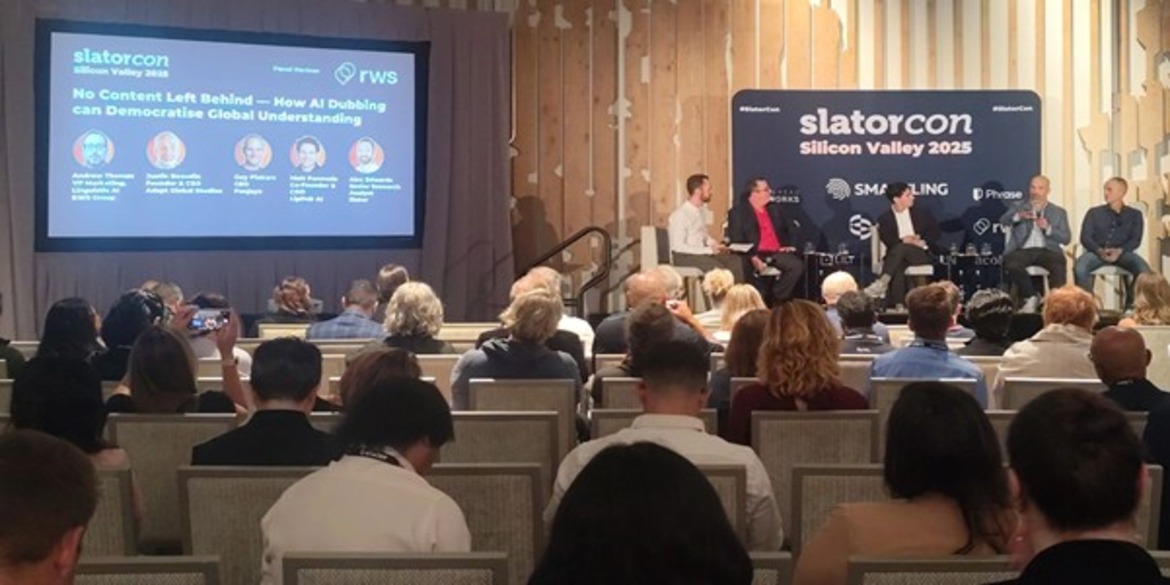Three themes that defined SlatorCon Silicon Valley 2025
11 Sep 2025
 5 mins
5 mins

If there was one clear takeaway from SlatorCon Silicon Valley 2025, it was that the conversation around AI has matured significantly. The language industry is clearly moving beyond the initial hype cycle and into a new phase of pragmatic, strategic application. The conversations on stage and in the hallways were less about abstract potential and more focused on the real-world complexities of making AI deliver tangible business results.
The day was packed with insights from leaders across the AI and language spectrum. This recap focuses on the themes that emerged from a few key sessions, including a deep dive into translation ROI from Bryan Murphy, CEO of Smartling; a technical look under the hood of large language models with Kelly Marchisio, Multilinguality Lead at Cohere; and a lively panel on AI dubbing that featured RWS’s own Andrew Thomas, alongside Justin Beaudin of Adapt Global Studios, Guy Piekarz of Panjaya and Matt Panousis of LipDub AI.
Theme 1: The new business case for localization
For years, we've championed the idea that localization must be seen as a powerful driver of enterprise growth, not a cost center. It was encouraging to see this strategic reframing emerge as a key theme at SlatorCon. In his session on "Driving ROI and Global Growth," Bryan Murphy made a compelling case that echoed this perspective, connecting high-quality localization directly to the ultimate marketing goal: personalization.
The argument was clear: we know personalization is a proven driver of conversion, and what is translating content for a specific market if not the most profound form of personalization? With 75% of internet users not having English as their first language and 65% of customers preferring to engage in their native tongue, the opportunity is immense.
Previously, the cost and time involved meant companies had to ration content, leaving this opportunity on the table. AI is changing this economic equation. The session highlighted the concept of Jevons paradox: as technology makes something more efficient, demand for it skyrockets. We’re seeing this in real-time. One analysis shared showed that as AI helped reduce the cost-per-word by 60%, the volume of content translated by clients grew by 255%.
The takeaway is powerful: AI doesn't shrink the market; it massively expands it by unlocking a vast amount of previously "untranslatable" content. This allows businesses to move from a defensive, cost-focused mindset to an offensive, growth-focused strategy, justifying investment by directly tying localization to revenue.
Theme 2: A reality check on a 'just use an LLM' strategy
While the potential of AI is undeniable, a strong dose of realism was present throughout the day. The simple, tempting idea of replacing complex workflows with a single, generic LLM is proving to be a flawed strategy. This was a recurring point, particularly in the session "Building Multilingual LLMs," presented by Kelly Marchisio, the multilingual team lead from Cohere, a frontier AI lab that trains models from scratch.
An eye-opening MIT study was cited, revealing that a staggering 95% of enterprise generative AI projects are failing due to a lack of clear goals, hidden operational costs and insufficient in-house expertise. The data presented by Cohere showed that the quality improvements from one generation of LLMs to the next have started to flatten out for specialized tasks like translation. According to the research, generic LLMs still produce roughly twice the errors of a professionally trained and adapted machine translation (MT) engine. When the cost of correcting those errors – or the brand and compliance risks of a single mistake – are factored in, the ‘free’ option becomes anything but.
The consensus is clear: we are moving away from the DIY phase and into an era of professional, purpose-built AI applications that are designed for specific, high-stakes tasks and integrate human expertise into the workflow.
Theme 3: AI dubbing and the new frontiers of accessibility
Perhaps the most exciting frontier discussed was the application of AI in media localization. The panel, "No Content Left Behind – How AI Dubbing can Democratise Global Understanding," brought together pioneers from leading AI dubbing and media localization providers. They framed the technology not just as an efficiency tool, but as a way to “democratize global understanding" by making high-quality dubbed content accessible for a whole new range of uses.
For decades, dubbing was largely confined to the film and TV industry. Now, AI is making it a viable option for:
- Corporate eLearning: Providing engaging video training to global teams in their native languages.
- Advertising and Marketing: Creating culturally relevant ads that look and feel as if they were filmed natively, boosting their cultural connection.
- The Creator Economy: Allowing social media creators to reach international audiences on platforms like YouTube and TikTok, turning their channels into global brands.
The conversation quickly turned to quality. While "one-shot" AI can work for simple, informational content, the panel agreed that high-stakes brand and entertainment content still requires a human in the loop to achieve perfection. The term "cultural ambassadors" described the experts who now use AI tools to craft the final performance, ensuring the emotional delivery and cultural nuances are just right. This blend of machine scale and human craft was a recurring theme.
The discussion also highlighted that a world-class experience goes beyond just the audio. As Matt Panousis, COO of LipDub AI , noted, "out-of-sync visuals represent a language barrier" in themselves. New lip-sync technologies are focused on creating a seamless viewing experience that feels completely natural, no matter the language.
Putting it all together
The overarching message from SlatorCon Silicon Valley was one of a maturing industry. The wide-eyed hype of early-stage AI is being replaced by a sophisticated, strategic approach focused on tangible results. The challenges are complex – from the hidden costs of tokenization to the quality degradation in quantized models – but the opportunities for businesses that get it right are enormous.
The path forward is not about choosing between AI and human expertise, but about intelligently weaving them together. The trends and challenges discussed at the conference are precisely the complexities we help our clients navigate every day. Building a robust, scalable and effective global content strategy requires a partner with deep expertise in both technology and language.
If you’re looking to move from AI experimentation to a clear strategy for global growth, we’d love to continue the conversation.
